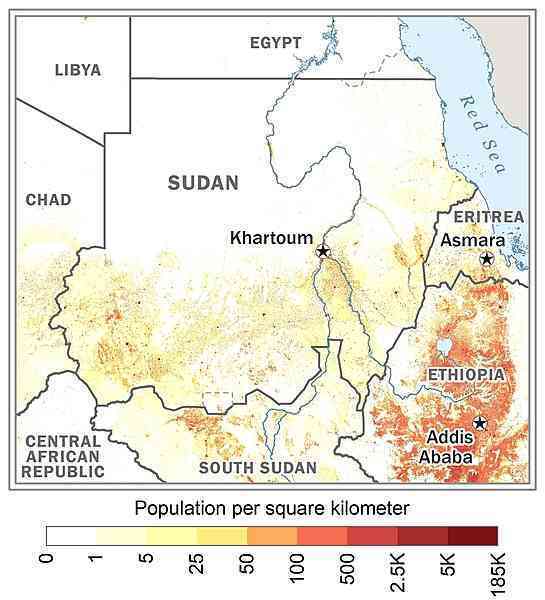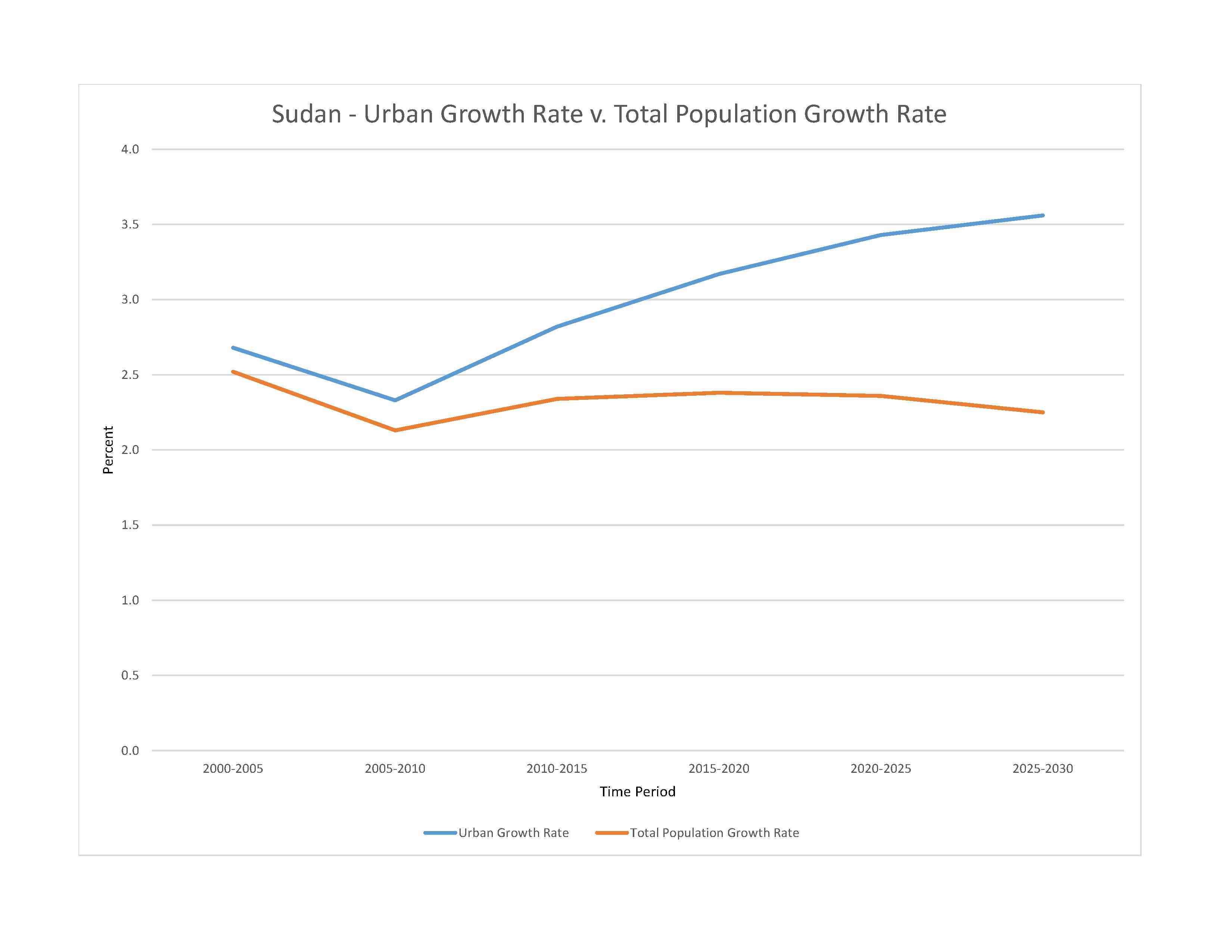
49,197,555 (2023 est.)
noun: Sudanese (singular and plural)
adjective: Sudanese
Sudanese Arab (approximately 70%), Fur, Beja, Nuba, Ingessana, Uduk, Fallata, Masalit, Dajo, Gimir, Tunjur, Berti; there are over 500 ethnic groups
Arabic (official), English (official), Nubian, Ta Bedawie, Fur
major-language sample(s):
كتاب حقائق العالم، المصدر الذي لا يمكن الاستغناء عنه للمعلومات الأساسية (Arabic)
The World Factbook, the indispensable source for basic information. (English)
Arabic audio sample:
Sunni Muslim, small Christian minority
Sudan’s population grew almost fourfold between 1956 and 2008, the date of its last census. Even after the southern part of the country became independent South Sudan in 2011, the population of Sudan has continued to grow. The gender balance overall is fairly even. Females, however, are more prevalent in rural areas because of males migrating to urban areas in search of work. The total fertility rate (TFR) remains high despite falling from 7 children per woman in Sudan’s first census in 1955 to about 4.5 in 2022, which can be attributed to early marriage and a low contraceptive prevalence rate. Among the factors that led to the reduction in fertility are family planning, improvement in women’s education and participation in the labor force outside the home, and migration and urbanization.
The continued slow decline in fertility accompanied by a drop in mortality and increased life expectancy has produced an age structure where approximately 55% of the population was of working age (15-64) as of 2020. This share will grow as the sizable youth population becomes working age. As Sudan’s working age population increasingly outnumbers the youth and elderly populations (the dependent populations), the country will approach the possibility of a demographic dividend. The window of opportunity for potential economic growth depends not only on a favorable age structure but also on having a trained and educated workforce, job creation (particularly in the formal market), and investment in health, as well as generating savings to invest in schooling and care for the elderly. As of 2018, Sudan’s literacy rate was just over 60%, and even lower among women. Improvements in school enrollment, student-teacher ratio, infrastructure, funding, and educational quality could help the country to realize a demographic dividend.
0-14 years: 40.47% (male 10,115,311/female 9,793,060)
15-64 years: 56.35% (male 13,774,002/female 13,946,621)
65 years and over: 3.19% (2023 est.) (male 814,480/female 754,081)
total dependency ratio: 76.9
youth dependency ratio: 74
elderly dependency ratio: 6.2
potential support ratio: 16.2 (2021 est.)
total: 19.1 years (2023 est.)
male: 18.8 years
female: 19.3 years
2.55% (2023 est.)
33.3 births/1,000 population (2023 est.)
6.2 deaths/1,000 population (2023 est.)
-1.6 migrant(s)/1,000 population (2023 est.)
with the exception of a ribbon of settlement that corresponds to the banks of the Nile, northern Sudan, which extends into the dry Sahara, is sparsely populated; more abundant vegetation and broader access to water increases population distribution in the south extending habitable range along nearly the entire border with South Sudan; sizeable areas of population are found around Khartoum, southeast between the Blue and White Nile Rivers, and throughout South Darfur as shown on this 
urban population: 36.3% of total population (2023)
rate of urbanization: 3.43% annual rate of change (2020-25 est.)

6.344 million KHARTOUM (capital), 1.057 million Nyala (2023)
at birth: 1.05 male(s)/female
0-14 years: 1.03 male(s)/female
15-64 years: 0.99 male(s)/female
65 years and over: 1.08 male(s)/female
total population: 1.01 male(s)/female (2023 est.)
270 deaths/100,000 live births (2020 est.)
total: 41.4 deaths/1,000 live births (2023 est.)
male: 46.9 deaths/1,000 live births
female: 35.7 deaths/1,000 live births
total population: 67.5 years (2023 est.)
male: 65.2 years
female: 69.8 years
4.54 children born/woman (2023 est.)
2.21 (2023 est.)
12.2% (2014)
improved: urban: 99% of population
rural: 80.7% of population
total: 87.1% of population
unimproved: urban: 1% of population
rural: 19.3% of population
total: 12.9% of population (2020 est.)
3% of GDP (2020)
0.26 physicians/1,000 population (2017)
0.7 beds/1,000 population (2017)
improved: urban: 72.1% of population
rural: 30.6% of population
total: 45.3% of population
unimproved: urban: 27.9% of population
rural: 69.4% of population
total: 54.7% of population (2020 est.)
degree of risk: very high (2023)
food or waterborne diseases: bacterial and protozoal diarrhea, hepatitis A and E, and typhoid fever
vectorborne diseases: malaria, dengue fever, Rift Valley fever, and sexually transmitted diseases: HIV/AIDS, hepatitis B (2024)
water contact diseases: schistosomiasis
animal contact diseases: rabies
respiratory diseases: meningococcal meningitis
note: on 31 August 2023, the US Centers for Disease Control and Prevention (CDC) issued a Travel Alert for polio in Africa; Sudan is currently considered a high risk to travelers for circulating vaccine-derived polioviruses (cVDPV); vaccine-derived poliovirus (VDPV) is a strain of the weakened poliovirus that was initially included in oral polio vaccine (OPV) and that has changed over time and behaves more like the wild or naturally occurring virus; this means it can be spread more easily to people who are unvaccinated against polio and who come in contact with the stool or respiratory secretions, such as from a sneeze, of an “infected” person who received oral polio vaccine; the CDC recommends that before any international travel, anyone unvaccinated, incompletely vaccinated, or with an unknown polio vaccination status should complete the routine polio vaccine series; before travel to any high-risk destination, the CDC recommends that adults who previously completed the full, routine polio vaccine series receive a single, lifetime booster dose of polio vaccine
6.6% (2014)
total: 1.93 liters of pure alcohol (2019 est.)
beer: 0 liters of pure alcohol (2019 est.)
wine: 0 liters of pure alcohol (2019 est.)
spirits: 0.29 liters of pure alcohol (2019 est.)
other alcohols: 1.63 liters of pure alcohol (2019 est.)
33% (2014)
61.4% (2023 est.)
N/A
definition: age 15 and over can read and write
total population: 60.7%
male: 65.4%
female: 56.1% (2018)
total: 8 years
male: 8 years
female: 7 years (2015)
NOTE: The information regarding Sudan on this page is re-published from the 2024 World Fact Book of the United States Central Intelligence Agency and other sources. No claims are made regarding the accuracy of Sudan 2024 information contained here. All suggestions for corrections of any errors about Sudan 2024 should be addressed to the CIA or the source cited on each page.
This page was last modified 04 May 24, Copyright © 2024 ITA all rights reserved.